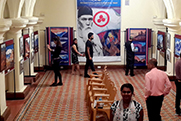
|

|
An exhibition on the life and creative work of the great Russian artist, scholar and thinker Nicholas Roerich opened on July 29, 2017 in Shimla, the capital of the northern Indian state of Himachal Pradesh, once the summer capital of British India.
The exhibition was organized by the Department of Language and Culture of the State Government of Himachal Pradesh, Shimla, and the International Roerich Memorial Trust (IRMT), Naggar, Kullu. The exhibits, including reproductions of Nicholas Roerich's paintings on canvas and silk, archive photos and information banners were earlier gifted to the IRMT by the International Centre of the Roerichs (ICR), Moscow, under the Agreement of Cooperation signed in 2012.
The exhibition was opened in the exhibition hall of the historic Gaiety Theater founded in 1887 and located in the very heart of Shimla – its doors are looking onto the central streets: Ridge and Mall. It was in the same Gaiety Theater, in the exhibition hall of the Lalit Kala Akademi (Academy of Arts), that the Indian leg of the ICR International Exhibition Project “The Roerich Pact. History and Modernity” started in 2014. Having started in Shimla, the exhibition travelled to such Indian cities as Chandigarh, Gandhinagar and Delhi. The permanent display under the same title also opened in the Roerich Estate in Naggar.
The exhibition, which opened its doors to the residents and numerous guests of Shimla on Saturday, was organized within the framework of the IRMT 25th anniversary celebrations. It tells about the life, creative and spiritual journey of Nicholas Roerich. It began in Russia, in St. Petersburg, where he was born and where he matured into an artist, archeologist, historian and culturologist. The image of his beloved Russian Land is one of the main themes of his art: we can find it in the pictures presented at the exhibition: Terra Slavonica, Now the Heavenly Powers are Invisibly Serving with Us, Pilgrim of the Radiant City created by the artist during his stay in India and dedicated to Russia.
A special section of the exhibition is dedicated to the famous Central Asian Expedition of Nicholas Roerich (1924-1928) which travelled through the most ancient cultural centers of Asia and collected rich research material. More than 500 paintings were created by the artist along the expedition route, including Maitreya the Conqueror, Banner of the Future, Lamayuru Monastery, etc. whose prints can be seen at the exhibition.
By the end of the expedition, at the close of 1928, the Roerichs came to the Kullu valley. Such paintings by Nicholas Roerich displayed at the exhibition as The Temple of Tripura Sundari, Guga Chauhan, Kuluta, and Shadow of the Master as well as archive photographs depicting Nicholas and Helena Roerich, their sons George and Svetoslav, as well as Devika Rani – the beautiful star of Indian cinema and the grandniece of Rabindranath Tagore, who married Svetoslav Roerich and joined the Roerich family in 1945, allow us to feel the beauty and uniqueness of this place where the memory of the sages, Rishis and Great Souls is still alive.
It was in Kullu that Nicholas Roerich drafted the world's first Treaty for the Protection of Cultural Properties known as the Roerich Pact. India was one of the first countries to support the Pact and raise the Banner of Peace as a symbol of the protection of Cultural values.
It was again in the Kullu valley that the Roerichs founded "Urusvati" Himalayan Research Institute, an important principle of which was the combination of ancient knowledge with the discoveries of modern science. The Institute studied man’s psychic energy, the energy of thought. “We are happy to see any achievement, whether it is in art or science," wrote Nicholas Roerich in his essay "Mysticism" responding to the comments on his “mysticism” that appeared in the press of various countries. “We are deeply interested in the transfer of thought at a distance and in everything connected with the energy of thought. It has long been the subject of our conversations with late Bekhterev, Rhein and Metalnikoff. The brain and heart areas that have been so much focused on by the scientists of the world recently, cannot be labeled with a hazy word “mysticism” but are the true scientific cognition.” He adds that "for the ignoramuses, probably, any scientific discovery is mysticism and supernaturalism."
The Roerichs’ life in Kullu was extremely eventful: work in the Institute, different creative activities, meetings with famous people. On one of the photos presented at the exhibition one can see Nicholas Roerich with Jawaharlal Nehru who visited the Roerichs in 1942. At this difficult time, they discussed the issues of Russian-Indian cooperation and laid foundations for strong friendship between Russia and India.
This April marks the 70th anniversary of the establishment of diplomatic relations between our two great countries. The exhibition that opened in Shimla, and all the cultural events that were conducted by the IRMT under the motto "India – Russia – The Roerichs" in 2017 are dedicated to this important event, as well as to the 25th anniversary of the IRMT.
The project is implemented with the support of the Himachal Pradesh Government, the Department of Language and Culture, Shimla, the Kullu District Administration, with the active participation of the Embassy of the Russian Federation in the Republic of India, New Delhi, and the International Center of the Roerichs, Moscow.
Read also the ICR site
|

